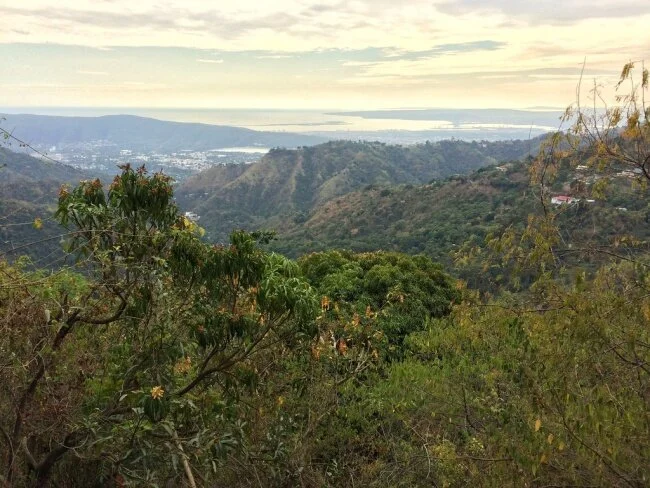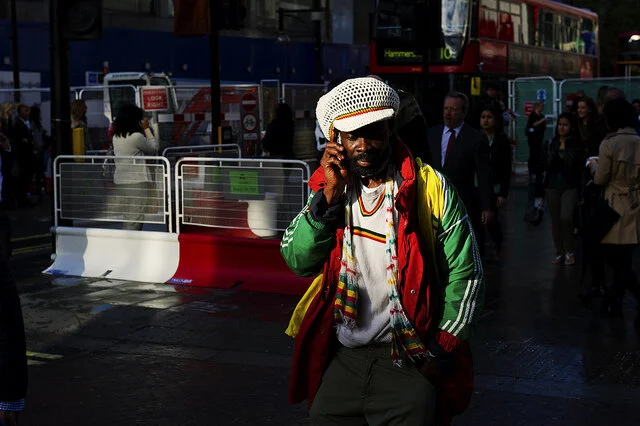Inside Jamaica’s Blue Mountains: A Stranger in their Midst
The ancient Land Rover banged through another pothole as the rain poured onto the muddy, treacherous road. “We’re almost there,” my husband shouted encouragingly. I nodded and clutched the door handle even tighter. Our little baby, carsick, had already thrown up twice. Driving from Kingston up 4000 feet into Jamaica’s Blue Mountains, with precipitous drops just steps away, frightened me into speechlessness. When the vehicle’s tires slipped at a hairpin turn, I silently begged God to keep us safe.
At last, we crunched up a bumpy driveway to Whitfield Hall, a centuries-old Blue Mountain coffee farm surrounded by giant eucalyptus trees. I unsnapped our child from her car seat and hurried after my husband Zickie. Outside in a covered breezeway under a kerosene lamp, a large Jamaican woman in a red headscarf held out her arms. “Miss Lynette!” Zickie bellowed, his stream of patois making her burst into belly laughs. I shivered with the baby as they embraced. Lynette Harriott was the matriarch who kept my in-laws’ 18th-century guesthouse running, just as her mother Cynthia once did. This was the first time I’d met her, on my very first trip to the island.
Finally, she turned to inspect me, the new American wife. Her mahogany-colored eyes moved swiftly from my muddied running shoes to my blond hair. “Laura,” she said formally. I shifted the baby to my hip as I moved in to give Lynette a hug. She responded stiffly. “It’s nice to meet you,” I began, telling her how much I’d heard about her. Lynette ignored this and reached for our baby.
“Likkle Iris,” she cooed, now smiling again. Other farmworkers crowded around to see the baby, the long-awaited grandchild of Mr. John and Miss Maureen. “Bright-eyed white lady,” an old man named Vinnie called her. Everyone laughed. I might as well have been invisible.
This was the beginning of my Blue Mountain education. The grinning, cheerful faces from Jamaican tourism ads have nothing to do with the close-knit, clannish world that exists in the hills. Nothing I’d read prepared me for the silent, assessing glances as someone started a fire in the old hall’s fireplace, or brought us a pot of strong tea. Lesson one: either you belong, or you’re merely tolerated.
Timidly, on that visit, I crept into the kitchen, where kerosene lamps cast reflections against the windows. “It’s nice not having electricity,” I suggested.
Lynette stared, then shook her head. “Me wish Whitfield did hav’ power,” she said. “Yes, sir, mek life a lot more easy.”
Back in the States, my husband spoke with nostalgia about the soothing hiss of Tilley lanterns in the evening. But for Lynette, the lack of electricity created an additional host of chores. After a few more visits to the mountains, I learned a second lesson: You rarely heard the famous Jamaican catchphrase, “No problem, mon.” But many, including Lynette, did say, “Life is hard.”
My response to their hardship, perhaps a typically American one, was to bring gifts each time we returned. Even this could be fraught with problems. When our child turned one, I gave Miss Lynette a bottle of lovely scented lotion.
“What’s this?” Perplexed, she queried my husband. “She t’ink me nuh smell nice?”
So began a series of misconceived presents for Lynette: a sweater that wasn’t nearly warm enough, waterproof shoes too narrow for her feet. Lesson three might have been “gifts don’t get you anywhere.” Eventually, with time, I learned the truth was more nuanced.
To my father-in-law’s dismay, I launched a project to redecorate the utilitarian, somewhat gloomy bedrooms with curtains and paint colors inspired by the house’s Georgian architecture. Here Lynette and I finally bonded. “I like color,” she told me emphatically when I showed her the first set of blue-and-cream curtains, which I’d sewn. The next set, made of red toile, won even more approval. “Mr. John like t’ing plain,” she confided. “But color me makes happy.” Finally, lesson four gonged through my head: no one up here wanted generic charity -- or well-intended but empty gestures. The following trip to Jamaica, when our daughter could now run, I brought Lynette a length of bright yellow print fabric, to sew whatever she wanted. “Yes,” she said simply, nodding. “I like.”
The next journey up, I found a jug of wildflowers beside our bed. Red, purple, yellow, pink, the blossoms brightened the small room. They meant more to me than a pile of gaudily wrapped Christmas presents. By now, I knew how to say my thanks. As Lynette placed dishes onto the long wooden table for dinner, I remarked casually, “There are some flowers in my room.”
Her eyes danced mischievously. “Yes?”
“I think they’re the prettiest flowers I’ve ever seen.”
She held a tray against her chest and chuckled, “Yes.” We smiled at one another. And then Lynette went back to work.
There were others I gradually got to know: Loxly, her son, who guides hikers to Blue Mountain peak, and Chippie, blind in one eye. Then there’s Lynette’s brother Roydel, who manages the coffee farm, and Wilbert, who worries about paying his sons’ school fees. Life high in the damp, misty mountains, far from grocery stores, gas stations, and doctor’s offices, is hard, harder than I can even imagine. Lesson five taught me that no matter how many times I journey up, I’ll always remain an outsider. It turns out, though, that there is a middle ground between those who belong and the merely tolerated: outsiders they like. All it takes to become one is a thick skin, an open heart, and about ten years of patience and persistence.
Laura Albritton is the author of a new guidebook, Miami for Families: A Vacation Guide for Parents and Kids (University Press of Florida). Her work regularly appears in the Miami Herald, Harvard Review, and Sculpture magazine; She's also written for publications such as the Houston Chronicle, Arts & Letters, and the Times Literary Supplement. She graduated with an MFA in Creative Writing from the University of Miami, where she was a James Michener Fellow.
Photo: Blue Mountains, Jamaica by Nick Sherman via Flickr CCL


